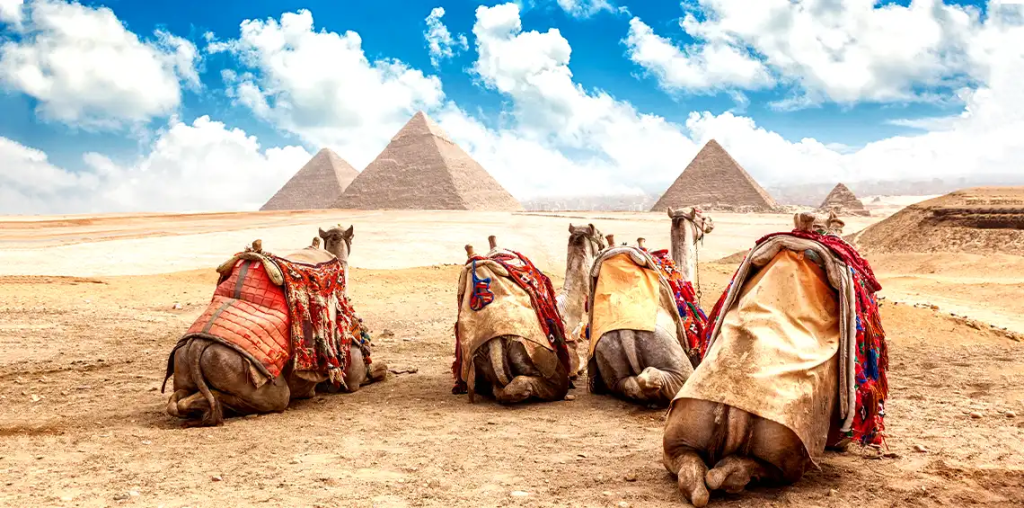
Nestled within the historic grounds of Saqqara, the Pyramid of Teti stands as a testament to the enduring allure and cultural significance of ancient Egypt. Built during the Sixth Dynasty, this pyramid is dedicated to Pharaoh Teti, a ruler whose legacy is etched into the annals of history through his remarkable funerary complex. In this comprehensive blog post, we embark on a journey to uncover the captivating history, architectural marvels, and ritualistic importance of the Pyramid of Teti.
Pharaoh Teti’s Legacy: The Pyramid of Teti, also known as the Pyramid of Teti I, honors Pharaoh Teti, a ruler of the Sixth Dynasty. Teti’s reign was marked by administrative reforms and religious changes, reflecting a dynamic era in ancient Egypt. The pyramid he commissioned reflects his position as a divine ruler and his quest for a triumphant afterlife.
Architectural Grandeur: Though not as monumental as the pyramids at Giza, the Pyramid of Teti exudes its own majesty. The pyramid’s base measures approximately 78 meters (256 feet) per side, and its original height reached around 52 meters (171 feet). The intricate construction techniques employed in its creation highlight the meticulous craftsmanship of ancient Egyptian builders.
Pyramid Complex and Rituals: The Pyramid of Teti forms the centerpiece of a sprawling complex that includes a mortuary temple, a causeway, a valley temple, and a pyramidion. These elements were meticulously designed to facilitate the rituals, ceremonies, and offerings that were crucial for the pharaoh’s successful journey to the afterlife. The texts inscribed on the walls of the pyramid provide invaluable insights into the ancient Egyptian beliefs and practices associated with death and the divine realm.
Unveiling Ritualistic Insights: The Pyramid Texts found within the Pyramid of Teti are some of the earliest known religious texts in ancient Egypt. They offer a captivating glimpse into the elaborate rituals, spells, and incantations performed to ensure the pharaoh’s safe passage to the afterlife. These texts emphasize the divine nature of the pharaoh, his communion with the gods, and his transformation into an eternal being.
Cultural and Spiritual Significance: The Pyramid of Teti serves as a nexus where ancient Egyptian culture, religion, and architecture converge. It represents the ancient belief in the connection between the earthly realm and the divine afterlife. Through its construction and inscriptions, it pays homage to Pharaoh Teti’s spiritual journey and serves as a beacon of hope for his eternal existence.
Preservation and Exploration: Efforts to preserve the Pyramid of Teti continue to provide insights into its history and cultural importance. Modern archaeological techniques allow researchers to unravel its secrets, leading to a deeper understanding of the rituals, architectural techniques, and religious practices of ancient Egypt.
Explore Egypt With Egypt Tours Expert
In the cradle of Egypt lie wondrous creations that defy imagination. Seize the opportunity to immerse yourself in the enchanting embrace of this majestic land through our meticulously crafted Egypt holiday tours from the UK.

4 Days Cairo and Abu Simbel Tour Package
Embark on an unforgettable 4-day tour package to Cairo and Abu Simbel, where ancient wonders and majestic temples await. Explore the iconic sites of Cairo, including the pyramids of Giza and the Egyptian Museum, before journeying to Abu Simbel to witness the breathtaking temples of Ramses II and Nefertari. With our carefully curated itinerary, knowledgeable guides, and inclusive services, this tour offers a compact yet immersive experience of Egypt’s rich history. Discover the secrets of the pharaohs, marvel at awe-inspiring architecture, and create lasting memories View Tour Details

5 Days Cairo and Alexandria Tour Package
Embark on a 5-day journey through Egypt’s most fascinating cities, Cairo and Alexandria. From the grand pyramids and ancient temples to the coastal beauty and cultural landmarks, this tour package is designed to showcase the best of both worlds. With expert guides, comfortable accommodations, and convenient transportation, you’ll have an immersive and hassle-free experience. Join us on this captivating adventure and create memories that will last a lifetime View Tour Details

6 Days Cairo, Luxor, Aswan & Abu Simbel Package
Embark on an extraordinary 6-day journey through the heart of ancient Egypt with our Cairo, Luxor, Aswan & Abu Simbel package. Begin your adventure in Cairo, where you’ll explore the iconic pyramids and delve into the treasures of the Egyptian Museum. Continue to Luxor and Aswan, where you’ll witness the grand temples along the Nile River, and conclude your tour with a visit to the awe-inspiring temples of Abu Simbel. With expert guides, comfortable accommodations, and hassle-free transportation, this package offers a comprehensive exploration of Egypt’s historic sites. Join us on this incredible journey and unlock the secrets of the pharaohs View Tour Details

7 Days Cairo, Luxor & Alexandria Tour
Experience the best of Egypt’s cultural and coastal attractions with our 7-day Cairo, Luxor & Hurghada holiday. Begin your journey in Cairo, where you’ll discover the iconic Pyramids of Giza, explore the ancient artifacts at the Egyptian Museum, and immerse yourself in the vibrant atmosphere of Egypt’s capital. Then, travel to Luxor, often referred to as the world’s greatest open-air museum, where you’ll explore magnificent temples, tombs, and archaeological sites. Finally, unwind in the idyllic beach destination of Hurghada, known for its pristine beaches and vibrant marine life View Tour Details
Related Egypt Tours Blog

Embark on an enchanting journey to the Giza Pyramids Complex, a testament to the ancient wonders of Egypt. Explore the iconic pyramids, unravel the mysteries of the Sphinx, and immerse yourself in the rich history of this UNESCO World Heritage Site. Join our guided tour to experience the awe-inspiring architecture, captivating legends, and breathtaking views of the Giza Plateau View Tour Details

The Saqqara Step Pyramid is a cornerstone of ancient Egyptian architecture, marking the transition from mastaba tombs to monumental pyramids. This guided tour takes you to Saqqara’s historical complex, where you’ll not only encounter the Step Pyramid but also explore fascinating tombs, chapels, and ancient structures View Tour Details

The Great Sphinx is an iconic masterpiece that has fascinated travelers for millennia. As you approach this enigmatic creature, you’ll feel the weight of history and the sense of wonder it evokes. Our expert guides will lead you through its mysteries and offer insights into the Sphinx’s role in ancient Egyptian culture View Tour Details
Pyramid of Teti FAQs
- What is the Pyramid of Teti? The Pyramid of Teti is an ancient Egyptian pyramid located in the Saqqara necropolis, near Cairo. It is the burial place of Pharaoh Teti, a ruler of the 6th Dynasty during the Old Kingdom.
- Who was Teti? Teti, also known as Pharaoh Teti, was a ruler of ancient Egypt during the 6th Dynasty. He is known for his reign’s historical and cultural contributions, as well as his pyramid complex.
- When was the Pyramid of Teti built? The construction of the Pyramid of Teti took place around 2323-2291 BCE during the Old Kingdom period of ancient Egypt.
- What is the significance of the Pyramid of Teti? The Pyramid of Teti is significant as the first known pyramid to include pyramid texts inside the burial chambers, providing valuable insights into ancient Egyptian beliefs about the afterlife.
- How does the Pyramid of Teti compare in size to other pyramids? The Pyramid of Teti is smaller in scale compared to some of the earlier pyramids, such as those on the Giza Plateau. However, its historical and cultural significance is noteworthy.
- What are the dimensions of the Pyramid of Teti? The Pyramid of Teti has a base measuring approximately 78.5 meters (257 feet) on each side and an original estimated height of around 52.5 meters (172 feet).
- Is the Pyramid of Teti open to visitors? Yes, the Pyramid of Teti is open to visitors as part of the Saqqara necropolis. Visitors can explore the exterior of the pyramid and, depending on conditions, might be allowed to enter the interior.
- Can visitors enter the interior of the Pyramid of Teti? As of my last update in September 2021, visitors are allowed to enter the Pyramid of Teti’s burial chamber. However, access policies might change, so it’s best to check with authorities or tour guides for the latest information.
- What can visitors see around the Pyramid of Teti? Visitors to the Pyramid of Teti can explore the pyramid complex, including the burial chamber with its inscriptions, as well as the surrounding Saqqara necropolis and other ancient structures.
- What makes the Pyramid of Teti unique in terms of its inscriptions? The Pyramid of Teti is renowned for the inclusion of the Pyramid Texts, a collection of religious and magical spells inscribed on the walls of the burial chamber. These texts offer insights into ancient Egyptian beliefs about the afterlife.
- Are there any legends or myths associated with the Pyramid of Teti? While the Pyramid of Teti might not have as many legends or myths as some other pyramids, its significance lies in the detailed inscriptions that provide important cultural and religious information.
- What is the significance of the Pyramid of Teti’s location in Saqqara? The Pyramid of Teti’s location in Saqqara is significant as it reflects the continuation of pyramid-building traditions during the 6th Dynasty and the continuation of burial practices in the area.
- What is the entrance to the Pyramid of Teti like? The Pyramid of Teti has an entrance on its north side that leads to a descending corridor and internal chambers, including the burial chamber.
- What can visitors learn from the Pyramid of Teti? The Pyramid of Teti offers insights into ancient Egyptian religious beliefs, rituals, and funerary practices, as well as the architectural and engineering achievements of the time.
- Are there any ongoing research or restoration efforts at the Pyramid of Teti? Ongoing research and restoration efforts are likely conducted to further understand the pyramid’s inscriptions, history, and significance and to ensure its preservation.
- Can visitors climb the Pyramid of Teti? Climbing the Pyramid of Teti might not be allowed due to preservation and safety concerns. However, visitors can still explore the complex and enjoy the historical site.
- What are the burial chambers inside the Pyramid of Teti used for? The burial chamber of the Pyramid of Teti was intended to house the pharaoh’s body, offerings, and funerary items, according to ancient Egyptian beliefs about the afterlife.
- Can I take photographs of the Pyramid of Teti? Photography regulations might vary, but in general, taking photographs around the Pyramid of Teti for personal use could be allowed. Always follow local guidelines.
- What should I keep in mind when visiting the Pyramid of Teti? When visiting the Pyramid of Teti, respect the historical site, adhere to local regulations, and appreciate the opportunity to explore a pyramid complex with unique inscriptions and cultural significance.
- What significance does the Pyramid of Teti hold in the study of ancient Egypt’s religious beliefs? The Pyramid of Teti’s inscriptions and Pyramid Texts are invaluable sources of knowledge about ancient Egyptian religious beliefs, cosmology, and rituals related to the pharaoh’s journey to the afterlife.

